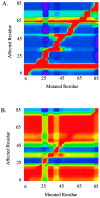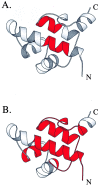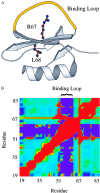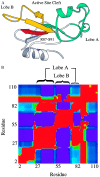The structural distribution of cooperative interactions in proteins: analysis of the native state ensemble
- PMID: 9707573
- PMCID: PMC21434
- DOI: 10.1073/pnas.95.17.9903
The structural distribution of cooperative interactions in proteins: analysis of the native state ensemble
Abstract
Cooperative interactions link the behavior of different amino acid residues within a protein molecule. As a result, the effects of chemical or physical perturbations to any given residue are propagated to other residues by an intricate network of interactions. Very often, amino acids "sense" the effects of perturbations occurring at very distant locations in the protein molecule. In these studies, we have investigated by computer simulation the structural distribution of those interactions. We show here that cooperative interactions are not intrinsically bi-directional and that different residues play different roles within the intricate network of interactions existing in a protein. The effect of a perturbation to residue j on residue k is not necessarily equal to the effect of the same perturbation to residue k on residue j. In this paper, we introduce a computer algorithm aimed at mapping the network of cooperative interactions within a protein. This algorithm exhaustively performs single site thermodynamic mutations to each residue in the protein and examines the effects of those mutations on the distribution of conformational states. The algorithm has been applied to three different proteins (lambda repressor fragment 6-85, chymotrypsin inhibitor 2, and barnase). This algorithm accounts well for the observed behavior of these proteins.
Figures






Similar articles
-
Rate-temperature relationships in lambda-repressor fragment lambda 6-85 folding.Biochemistry. 2004 Oct 19;43(41):13018-25. doi: 10.1021/bi049113b. Biochemistry. 2004. PMID: 15476395
-
A genetic algorithm that seeks native states of peptides and proteins.Biophys J. 1995 Aug;69(2):340-55. doi: 10.1016/S0006-3495(95)79906-4. Biophys J. 1995. PMID: 8527647 Free PMC article.
-
Kinetic role of helix caps in protein folding is context-dependent.Biochemistry. 2004 Apr 6;43(13):3814-23. doi: 10.1021/bi035683k. Biochemistry. 2004. PMID: 15049688
-
Protein folding from a combinatorial perspective.Fold Des. 1996;1(2):R27-30. doi: 10.1016/S1359-0278(96)00015-6. Fold Des. 1996. PMID: 9079366 Review.
-
Fluorescence spectroscopic studies of proteins.Subcell Biochem. 1995;24:101-14. doi: 10.1007/978-1-4899-1727-0_4. Subcell Biochem. 1995. PMID: 7900173 Review. No abstract available.
Cited by
-
New concepts in pharmacological efficacy at 7TM receptors: IUPHAR review 2.Br J Pharmacol. 2013 Feb;168(3):554-75. doi: 10.1111/j.1476-5381.2012.02223.x. Br J Pharmacol. 2013. PMID: 22994528 Free PMC article. Review.
-
The propagation of binding interactions to remote sites in proteins: analysis of the binding of the monoclonal antibody D1.3 to lysozyme.Proc Natl Acad Sci U S A. 1999 Aug 31;96(18):10118-22. doi: 10.1073/pnas.96.18.10118. Proc Natl Acad Sci U S A. 1999. PMID: 10468572 Free PMC article.
-
Protein structure change studied by hydrogen-deuterium exchange, functional labeling, and mass spectrometry.Proc Natl Acad Sci U S A. 2003 Jun 10;100(12):7057-62. doi: 10.1073/pnas.1232301100. Epub 2003 May 28. Proc Natl Acad Sci U S A. 2003. PMID: 12773622 Free PMC article.
-
Quantifying information transfer by protein domains: analysis of the Fyn SH2 domain structure.BMC Struct Biol. 2008 Oct 8;8:43. doi: 10.1186/1472-6807-8-43. BMC Struct Biol. 2008. PMID: 18842137 Free PMC article.
-
Thermodynamic mechanism for the evasion of antibody neutralization in flaviviruses.J Am Chem Soc. 2014 Jul 23;136(29):10315-24. doi: 10.1021/ja503318x. Epub 2014 Jul 8. J Am Chem Soc. 2014. PMID: 24950171 Free PMC article.
References
-
- Lumry R, Biltonen R, Brandts J F. Biopolymers. 1966;4:917–944. - PubMed
-
- Clarke J, Fersht A R. Fold Des. 1996;1:243–254. - PubMed
-
- Jeng M-F, Englander S W. J Mol Biol. 1991;221:1045–1061. - PubMed
-
- Radford S E, Buck M, Topping K D, Dobson C M, Evans P A. Proteins. 1992;14:237–248. - PubMed
-
- Loh S N, Prehoda K E, Wang J, Markley J L. Biochemistry. 1993;32:11022–11028. - PubMed
Publication types
MeSH terms
Substances
Grants and funding
LinkOut - more resources
Full Text Sources
Other Literature Sources
Research Materials

